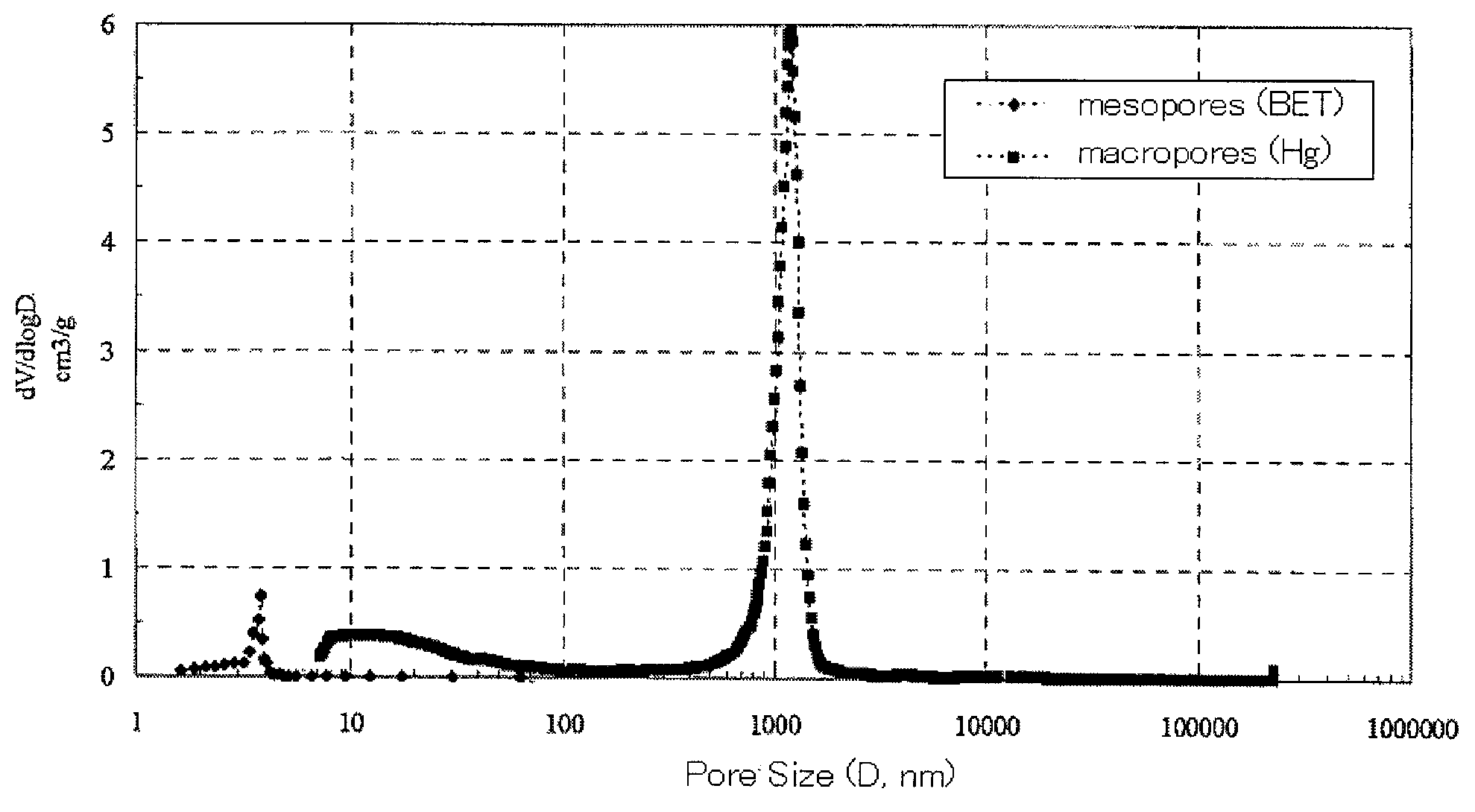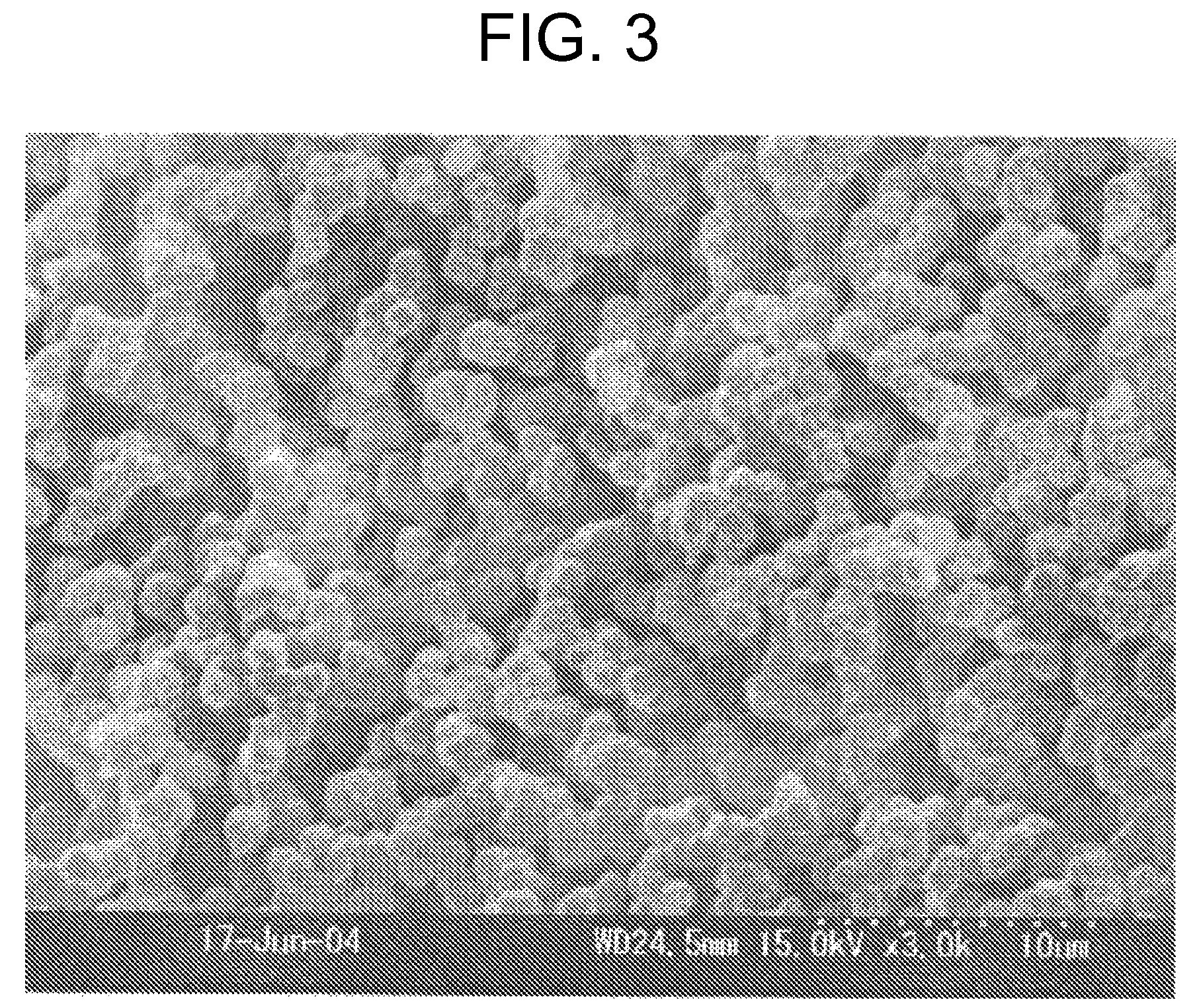Porous polymer and process for producing the same
a porous polymer and polymer technology, applied in the field of polymeric porous materials, can solve the problems of poor solvent separation capacity, lower separation efficiency, and poor aggregated polymer molecules that evolved from monomers, and achieve the effect of superior separation capacity
- Summary
- Abstract
- Description
- Claims
- Application Information
AI Technical Summary
Benefits of technology
Problems solved by technology
Method used
Image
Examples
example 1
[0108]Into a test tube (internal diameter 10 mm, length 200 mm) was added 1.86 ml of a distilled chlorobenzene (χ about 0.37). Thereto was added 55.8 mg of a flake powder of ultrahigh molecular weight polystyrene (Mw=3,840,000, Mw / Mn=1.04; Tosoh) at a room temperature. The mixture was gently agitated with a spatula to diffuse the polystyrene flake, and then the test tube was immersed in an ultrasonic agitation bath (Branson Ultrasonic Cleaner) for 10 minutes. After that, the test tube was let stand for 24 hours at a room temperature to give a transparent polymer porogen solution.
[0109]Next, 10 mg of 2,2′-azobisisobutyronitrile (Mw=164.21, 98%, Nacalai Tesque) was added to the polymer porogen solution, and dissolved in the solution by handshaking. Then, 1 ml of glycerol dimethacrylate (GDMA; KYOEISHA CHEMICAL, GP-101 P, molecular weight 227) was added to the solution to give a uniform transparent polymerization solution. After bubbling this polymerization solution with an argon gas f...
example 2
[0112]The polymerization was carried out in the same manner as in Example 1 except that GDMA was changed to ethylene dimethacrylate (EDMA; χ about 0.36, KYOEISHA CHEMICAL, molecular weight 198, distilled at 64° C., 25 mmHg), 2,2′-azobisisobutyronitrile was changed to 2,2′-azobis(2,4-dimethyl)valeronitrile (Mw=248.37, 95%, WAKO chemicals). As a result, the test tube was filled up to a height of 4 cm from its bottom with a white solid. After drying the solid, the mesopores and the macropores of the dried sample were measured in the same manner as in Example 1. From the measurement results, the proportion of the specific surface area of the macropores to the specific surface area of all pores was calculated. The results are shown in Table 1. The pore size distribution is shown in FIG. 2. As in the case of Example 1, a bimodal distribution with sharp peaks located at 4 nm in a mesopore range and located within a range from 1 to 2 μm in a macropore range was observed.
example 3
[0113]A polymerization solution of GDMA was prepared in the same manner as in Example 2 except that EDMA was changed to GDMA, and stored in a refrigerator. Then, a fused silica capillary coated with polyimide (internal diameter 200 μm) was cut as a coil having a length of about 180 cm, and 1 N aqueous NaOH solution was injected into the coil by a syringe. After sealing the both ends of the capillary coil, the coil was treated in a water bath at 60° C. for 1 hour. Then, the capillary coil was sequentially washed with excessive amounts of acetone and pure water in repeating fashion. The washed capillary coil was dried by a hot-air dryer at 160° C. for 24 hours.
[0114]Then, the above-mentioned stored GDMA solution was charged into the capillary coil by using a syringe pump (Harvard Apparatus Model 11) at a room temperature. After that, the both ends of the capillary coil were immediately sealed with a parafilm. Then, the polymerization was carried out in a water bath set at 60° C. for 2...
PUM
| Property | Measurement | Unit |
|---|---|---|
| pore size | aaaaa | aaaaa |
| pore size | aaaaa | aaaaa |
| pore size | aaaaa | aaaaa |
Abstract
Description
Claims
Application Information
 Login to View More
Login to View More - R&D
- Intellectual Property
- Life Sciences
- Materials
- Tech Scout
- Unparalleled Data Quality
- Higher Quality Content
- 60% Fewer Hallucinations
Browse by: Latest US Patents, China's latest patents, Technical Efficacy Thesaurus, Application Domain, Technology Topic, Popular Technical Reports.
© 2025 PatSnap. All rights reserved.Legal|Privacy policy|Modern Slavery Act Transparency Statement|Sitemap|About US| Contact US: help@patsnap.com



